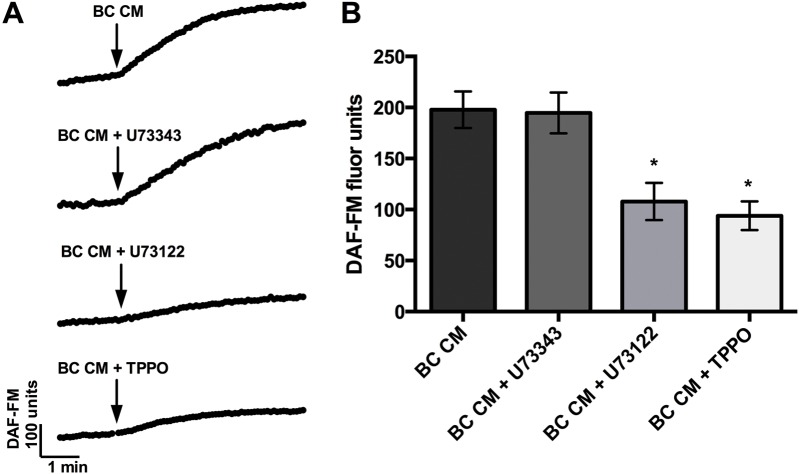Figure 3.
Bacillus cereus CM–induced NO generation is partially blocked by inhibitors of PLCβ-2 and TRPM5 dependent signaling. (A) Representative traces of DAF-FM fluorescence increases over time of cultures stimulated with B. cereus CM alone or in the presence of the PLCβ-2 inhibitor (B. cereus CM + U73122), inactive PLCβ-2 inhibitor analog (B. cereus CM + U73343), or TRPM5 blocker (B. cereus CM + TPPO). (B) Bar graphs of the average DAF-FM fluorescence (n = 5–8 cultures from five to seven patients for each condition) of cultures stimulated with B. cereus CM alone or in the presence of PLCβ-2 inhibitor (B. cereus CM + U73122), inactive PLCβ-2 inhibitor analog (B. cereus CM + U73343), or TRPM5 blocker (B. cereus CM + TPPO). After stimulation with B. cereus CM, DAF-FM fluorescence increases were 197.8 ± 17.85 (B. cereus CM) versus 194.7 ± 20.05 (B. cereus CM + U73343; n.s. by using one-way ANOVA with Bonferroni posttest) versus 107.9 ± 18.16 (B. cereus CM + U73122; p < 0.01) versus 93.90 ± 14.11 (B. cereus CM + TPPO; p < 0.01) The data in the graph are average ± SE; *p < 0.01. CM = Conditioned medium; NO = nitric oxide; PLCβ-2 = phospholipase C β-2; TRPM5 = transient receptor potential melastatin isoform 5 ion channel; DAF-FM = 4-amino-5-methylamino-2′,7′-difluorofluorescein; TPPO = triphenylphosphine oxide; n.s. = no statistical significance; ANOVA = analysis of variance.

